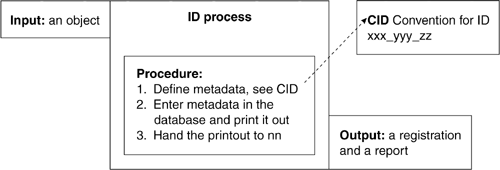24.1 Processes in General
| When a company has gained some experience in and understanding of configuration management, it can begin collecting, documenting, and improving relevant process descriptions. Connection with Maturity ModelsCapability level 3 for configuration management in CMMI or BOOTSTRAP is reached when a company has defined its processes for configuration management so all projects can use the processes. The description must contain guidelines for how projects may tailor the processes to their needs. The process descriptions apply to the entire company or a welldefined part, such as a department. Based on their experiences with the process descriptions, users must provide feedback to the person responsible for maintaining the processes. DefinitionsThe words "process," "procedure,"and so on are often used at random. The following definitions (a free interpretation of the dictionary definitions and the common understanding and use of the words) are used here: A process describes how an input is used to create the expected output. A process is the descriptions of techniques, methods , procedures, conventions, and templates to be deployed within a specific area. All these words ("technique," "method," and "procedure") cover the same concept: the way to do something. A procedure is a description of a number of actions to be performed in a sequence. A convention is guidelines for how to construct (or understand) something. A template is a description of the usual look or layout of something, sometimes including guidelines to make a copy of the item. A process must always have, at the very least, input, procedure, and output. The procedure may refer to other procedures, conventions, and/or templates. A Process Is Like a RecipeAn analogy is sometimes made between a process description and a recipe. That analogy is not far off. A recipe includes a list of ingredients (input), workflow, and a descriptionmaybe even a pictureof the expected result. A recipe may also include information about skills required to follow the instructions, suggestions for tools to use, expected time to produce the result, and expected calorie count. A recipe may be scalableit's just a matter of multiplying the ingredients by the correct factor. Or it may not be scalable, say if you are cooking for a large number of people. It may be customized if some ingredient has to be substituted. An identification process may be needed within the scope of configuration management. Figure 24-1 shows a simplified version. Figure 24-1. Simple Identification Process Process ModelA high-quality configuration management system is characterized by all necessary processes being described, integrated, and automated to the highest possible degree, providing a complete workflow solution. It may be a good idea to produce a process model for all processes, to illustrate how they interact. This will provide an overview and a way to verify that all are used, all have input created in another process, and all have output used in at least one other process. A process model may also describe how responsibilities are assigned, providing an overview of who does what. Process models may be produced to almost any level of abstraction. Start with the highest abstraction level and work your way down to the details, which have different intended audiences. The highest abstraction level may be for the CEO to get an overall understanding of the area, and the lowest level may be for an employee to perform a specific task. To stay in the recipe analogy, a process model may be an overall description of how to produce a three-course meal, set the table, and serve the guests. It may include references to the recipes and other descriptions used by the staff, such as the dessert cook or the waiter. Don't underestimate the work involved in producing process models and process descriptions. It takes a long time, and it often requires a number of iterations to get it right. Don't be too ambitious to start with. It's better for descriptions to be a bit coarse rather than too fine. The latter will discourage both the people writing them and the people using them. Furthermore, as the world is never satisfied nor stable, the descriptions will have to be flexible and changeable over time. This brings the company on toward capability levels 4 and 5. |
EAN: 2147483647
Pages: 181
- Structures, Processes and Relational Mechanisms for IT Governance
- Assessing Business-IT Alignment Maturity
- Linking the IT Balanced Scorecard to the Business Objectives at a Major Canadian Financial Group
- A View on Knowledge Management: Utilizing a Balanced Scorecard Methodology for Analyzing Knowledge Metrics
- Managing IT Functions
